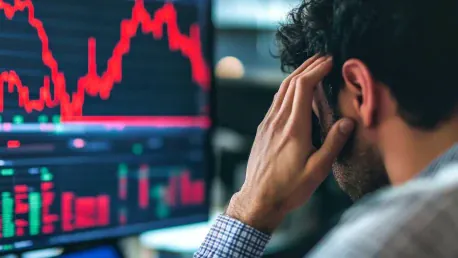Renowned investor and financial educator Robert Kiyosaki has once again stirred the financial world with his prediction of a “giant crash” in the market. Known for his contrarian views and skepticism of the traditional financial system, Kiyosaki argues that the economy is on the brink of collapse, fueled by what he refers to as the ‘everything bubble.’ This article examines whether Kiyosaki’s forecast is coming true by analyzing historical accuracy, current market conditions, and investor strategies. With investors on edge, the question remains: Is this a genuine warning or another premature alarm?
The Everything Bubble and Monetary Policy
Kiyosaki contends that central banks’ excessive money printing and historically low interest rates have artificially inflated nearly all asset classes, including stocks, bonds, real estate, gold, silver, and Bitcoin. As central banks begin to tighten monetary policy, he predicts that asset prices will experience a sharp correction. The focus on inflation control and rising interest rates by central banks could lead to a significant sell-off in various asset classes, validating Kiyosaki’s concerns. This scenario is particularly worrisome as the artificial inflation of values threatens long-term economic stability.
The reversal of these monetary policies is seen as a major trigger for the anticipated market crash. Investors, who have grown accustomed to easy money and high valuations, may find it challenging to adjust to a new reality where credit is less accessible and more expensive. This transition period, marked by policy tightening and increasing interest rates, could likely expose the overvaluation in numerous markets. Whether this adjustment will lead to the dramatic crash Kiyosaki predicts is a question that keeps financial experts divided, highlighting the uncertainty inherent in economic forecasting.
Debt Crisis and Inflation Concerns
With record levels of global debt, rising interest rates will make it increasingly difficult for governments, corporations, and individuals to service their obligations. This unsustainable debt level is a critical factor in Kiyosaki’s prediction of a market crash. As debt repayment costs rise, the risk of defaults increases, potentially setting off a chain reaction that could destabilize financial markets. This precarious situation only amplifies the potential impact of Kiyosaki’s forecast, suggesting that the next financial crisis may be fueled by a combination of debt overload and tightening monetary policies.
In addition to the debt crisis, Kiyosaki warns of stagflation, where economic growth falls while prices continue to rise. This combination of high debt and inflation could exacerbate economic instability and contribute to the predicted market downturn. The specter of stagflation presents significant challenges for policymakers and investors alike, as traditional strategies to combat inflation, like raising interest rates, could simultaneously stifle economic growth. The balancing act required to navigate these turbulent waters underscores the complexity of the current financial landscape and the potential accuracy of Kiyosaki’s dire predictions.
Stock Market and Real Estate Trends
Kiyosaki claims that the stock market has been propped up by easy money policies, but the reality of rising interest rates and slowing economic growth could lead to a significant sell-off. Recent declines in major indices like the S&P 500, Dow Jones Industrial Average, and Nasdaq may reflect growing investor concerns about inflation, interest rates, and economic stability, echoing Kiyosaki’s warnings. If these trends continue, the market could face prolonged downward pressure, leading to further examination of the structural weaknesses within the stock market that have been masked by years of accommodative monetary policies.
In high-demand urban areas, rising mortgage rates and economic uncertainty could precipitate a housing market crash after significant price appreciation. This potential decline in real estate values is another aspect of Kiyosaki’s forecast. The sharp increase in property values over recent years has been driven by low borrowing costs and high demand. However, with mortgage rates on the rise, housing affordability is reaching concerning levels, making it difficult for prospective buyers to enter the market. This drop in demand could lead to a downward spiral in home prices, mirroring the broader economic challenges highlighted by Kiyosaki.
Cryptocurrency and Bitcoin
Despite being bearish on most markets, Kiyosaki views Bitcoin as “people’s money” and a hedge against systemic risk. He believes it will be the fastest asset to recover after a market crash, providing a unique perspective on the role of cryptocurrencies in the current financial landscape. Bitcoin’s decentralized nature and limited supply give it qualities that proponents argue make it a reliable store of value, especially during times of financial instability. This belief underpins Kiyosaki’s bullish stance on Bitcoin amidst his broader market pessimism, positioning it as a potentially stabilizing force in a tumultuous financial environment.
Bitcoin’s volatility and increasing institutional support suggest that it may indeed serve as a store of value if traditional markets collapse. This aligns with Kiyosaki’s bullish stance on Bitcoin amidst his broader market pessimism. Additionally, the growing acceptance of Bitcoin by major financial institutions and corporations enhances its legitimacy as an investment vehicle. While its price fluctuations can be extreme, the underlying technology and philosophy of decentralization continue to attract investors looking for an alternative to traditional financial systems. Whether Bitcoin will fulfill this role during a market crash remains to be seen, but its potential can’t be overlooked.
Historical Context and Kiyosaki’s Track Record
Kiyosaki has a history of making bold financial predictions, some of which proved accurate. His 2002 book, Rich Dad’s Prophecy, warned of an impending stock market crash, which materialized in 2008 due to the subprime mortgage crisis. This prior correct prediction adds a layer of credibility to his current warnings, suggesting that his contrarian perspective may sometimes yield valuable insights. The recognition of past successes is important, as it provides context and a benchmark against which to measure his latest claims. However, relying solely on historical accuracy can be misleading, given the ever-changing nature of the financial markets.
Kiyosaki also foresaw a market downturn linked to excessive debt and economic instability, partially realized during the COVID-19 pandemic. However, not all of his bearish predictions have manifested as expected, leading some critics to argue that his warnings can be premature or overly alarmist. The mixed track record of Kiyosaki’s predictions serves as a reminder that while his insights can be valuable, they should be considered as part of a broader analysis rather than taken at face value. Critics emphasize the importance of not succumbing to fear-driven speculation without grounding financial decisions in comprehensive research and professional guidance.
Current Market Conditions and Analysis
As of February 2025, the S&P 500, Dow Jones Industrial Average, and Nasdaq have all shown declines of around 1.70% to 2.05%. This suggests that market participants may be concerned about inflation, interest rates, and economic growth, echoing Kiyosaki’s warnings. Such declines in major indices indicate a broader apprehension among investors, potentially validating elements of Kiyosaki’s forecast. This data provides a tangible link between his predictions and current market movements, underscoring the relevance of his concerns in light of observable trends. The ongoing fluctuations in these indices will likely continue to be a focal point for investors and analysts.
Rising mortgage rates have led to the lowest housing affordability in decades, and the demand for office space is struggling due to the persistence of remote work. These trends in the bond and real estate markets further support the potential validity of Kiyosaki’s predictions. The impact on housing affordability is particularly notable, as it not only affects potential homebuyers but also has broader implications for economic stability and growth. The challenges faced by the commercial real estate sector in adapting to new work environments highlight the interconnectedness of various financial markets and the ripple effects that can arise from shifts in monetary policy and economic conditions.
Investor Preparation Strategies
While predicting the exact timing of market crashes is notoriously difficult, investors can take proactive measures to protect their portfolios. Diversification, focusing on quality investments, holding cash reserves, and investing in inflation hedges like gold and silver are prudent strategies. These approaches help mitigate risks and enhance resilience against market volatility. By spreading investments across various asset classes and prioritizing financially sound companies, investors can better withstand economic downturns. Maintaining cash reserves provides liquidity, allowing investors to seize opportunities when asset prices drop. Additionally, precious metals like gold and silver have historically maintained value during periods of inflation, offering a safeguard for purchasing power.
Market downturns can offer buying opportunities for long-term investors. Staying disciplined, informed, and avoiding panic are essential tactics to navigate potential financial turbulence and safeguard wealth against downturns. By remaining focused on long-term goals and not reacting impulsively to market fluctuations, investors can capitalize on undervalued assets during periods of market stress. Informed decision-making, supported by comprehensive research and professional advice, equips investors to make thoughtful adjustments to their portfolios. Ultimately, while the timing and extent of market crashes may be uncertain, adopting a proactive and balanced approach to investment can help mitigate risks and ensure financial stability.
Conclusion: Preparing for the Uncertain Financial Future
Renowned investor and financial educator Robert Kiyosaki has once again made waves in the financial community with his prediction of a “giant crash” looming in the market. Famous for his contrarian views and his skepticism towards the conventional financial system, Kiyosaki insists that the economy is teetering on the edge of collapse, driven by what he dubs the ‘everything bubble.’ This article delves into the possibility of Kiyosaki’s forecast materializing by examining his historical accuracy, the current state of the market, and strategies investors might consider. With many investors feeling uneasy, the core of the debate remains: Is Kiyosaki offering a genuine warning rooted in reliable analysis, or is this another instance of an alarm sounded too early? Understanding the validity of his prediction requires a nuanced look at past trends and present economic indicators to determine if we are indeed on the cusp of a major market downturn or if fears are being exaggerated.









